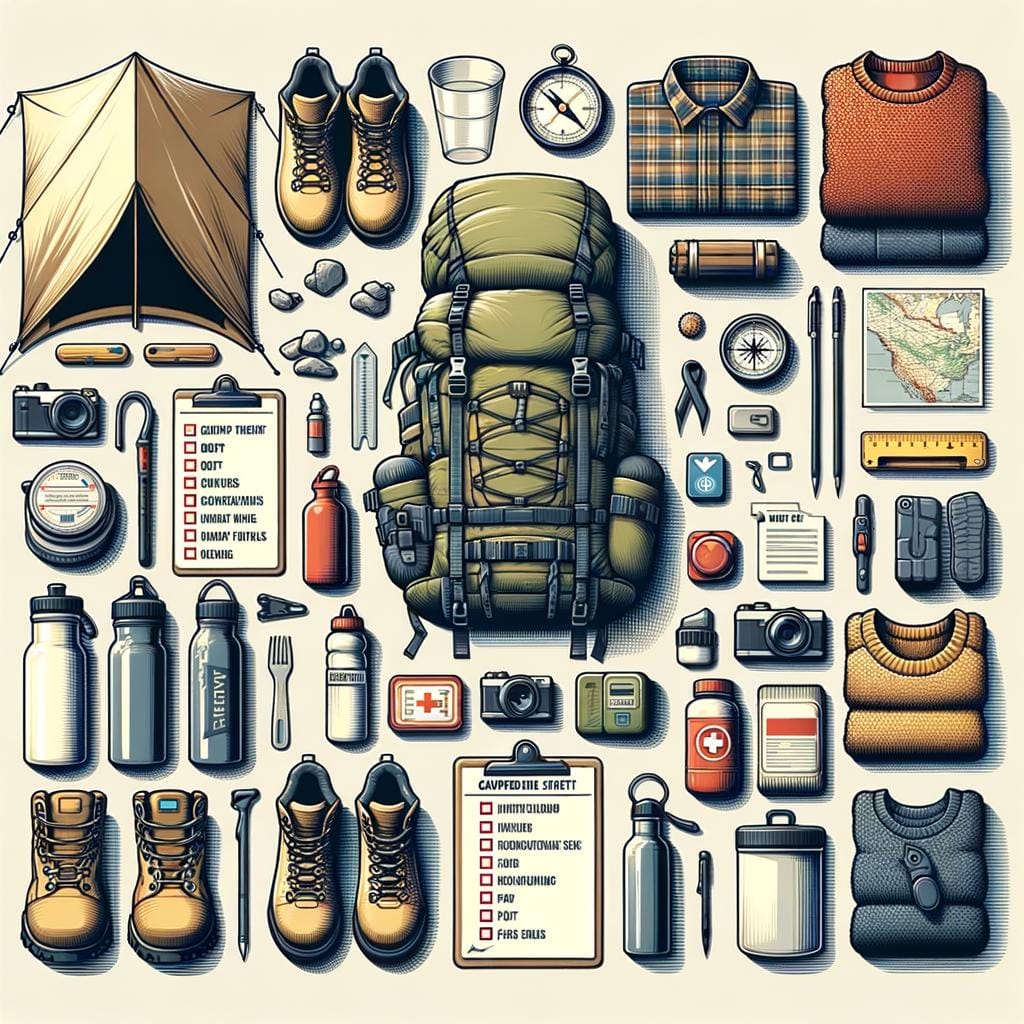Embarking on backpacking plans can be one of the most exhilarating experiences for adventure-seekers. The allure of exploring new destinations, immersing oneself in nature, and conquering challenging terrains is enough to get any traveler’s heart racing. The thrill of planning every detail of a backpacking trip, from researching potential destinations to choosing the right gear, adds an extra layer of excitement to the journey ahead.
There is a certain sense of freedom that comes with backpacking – the ability to pack all your essentials into a single bag and set off on an adventure with nothing holding you back. The process of researching and preparing for a backpacking trip can be just as thrilling as the journey itself. From reading up on different destinations to scouting out the best hiking trails, every step taken towards planning a backpacking adventure is filled with anticipation and excitement.
As backpackers start envisioning their upcoming escapades, the possibilities seem endless. Whether it’s trekking through lush forests, climbing mountain peaks, or setting up camp by a serene lake, each aspect of planning a backpacking trip contributes to the overall excitement of the experience.
In the following sections, we will delve deeper into tips for research and preparation, choosing the right gear, route planning, safety precautions, budgeting and finance, accommodation options, and sustainable travel practices for those ready to embark on their backpacking plans.
Research and Preparation
Embarking on a backpacking adventure is an exciting and liberating experience that allows you to immerse yourself in nature, culture, and new experiences. The first step in planning your backpacking trip is conducting thorough research to ensure a memorable and smooth journey.
Research plays a crucial role in selecting the right destination based on your interests, skill level, and timeframe. Whether you aspire to hike through lush forests, traverse challenging mountain trails, or explore picturesque coastal routes, there are endless possibilities awaiting you.
Researching Potential Backpacking Destinations
When researching potential backpacking destinations, consider factors such as the seasonality of your chosen location, visa requirements for international travel, cultural norms and customs, availability of supplies along the route, as well as safety and security considerations. Online resources such as travel blogs, forums, and official tourism websites provide valuable insights into popular backpacking trails worldwide. Additionally, guidebooks and maps can offer detailed information on hiking routes, points of interest, camping sites, and local amenities.
Preparing for the Trip
Once you have selected your desired backpacking destination(s), it is essential to begin preparing for your adventure meticulously. Make sure to check the weather forecast for your chosen travel dates to pack suitable clothing and gear accordingly. Create a comprehensive packing list including essentials such as a sturdy tent, sleeping bag, cooking supplies, first aid kit, navigation tools (compass or GPS device), water purification system or tablets – depending on the availability of clean water sources along your route.
Moreover, ensure that you inform someone about your itinerary before embarking on your journey in case of emergencies. By dedicating time to research and preparation before setting off on your backpacking plans will help guarantee a successful and enjoyable experience in the great outdoors.
Choosing the Right Gear
When embarking on a backpacking adventure, one of the most crucial aspects to consider is choosing the right gear. The equipment you bring along can make or break your experience in the great outdoors. From hiking boots to sleeping bags, having the proper gear not only ensures your comfort but also your safety during the journey. Here are some essential items to include in your backpacking plans:
- Backpack: A sturdy and comfortable backpack is essential for carrying all your gear. Look for one with padded straps and multiple compartments for organization.
- Tent: If you plan on camping during your backpacking trip, a reliable tent is a must. Consider factors like weight, size, and ease of setup when selecting a tent for your adventure.
- Sleeping Bag: A high-quality sleeping bag is key to staying warm and comfortable at night. Choose one that suits the climate of your destination and provides adequate insulation.
In addition to these essentials, other gear such as a portable stove, water filter or purifier, navigation tools (like a map and compass), first aid kit, and clothing suitable for various weather conditions should also be included in your packing list. When selecting gear for your backpacking trip, it’s important to consider factors like weight, durability, and functionality. Opt for lightweight yet durable materials that can withstand the demands of outdoor adventures.
Researching different brands and reading reviews can help you narrow down your choices and find the best gear for your needs. Consider renting or borrowing certain items if you’re on a budget or unsure about making a long-term investment in specific equipment. Properly preparing and selecting the right gear will set you up for a successful and enjoyable backpacking experience. So make sure to include thorough research on gear selection in your backpacking plans before hitting the trail.
Route Planning
Another important factor to consider when planning your backpacking route is the weather conditions. Researching the typical weather patterns of your chosen destination can help you pack appropriate clothing and gear, as well as anticipate any potential challenges due to extreme weather conditions. It’s essential to be prepared for changing weather conditions while on the trail, so make sure to pack items like a waterproof jacket, extra layers, and sun protection.
Distance is also a critical factor when mapping out your backpacking route. Consider your fitness level and hiking experience when planning how many miles you can comfortably cover each day. Take into account any elevation gain or loss along the trail, as this can significantly impact your pace and energy levels.
Additionally, plan for rest days or shorter hiking days to avoid burnout and allow time to enjoy the scenery along the way. By carefully considering terrain, weather, and distance when mapping out your backpacking route, you can ensure a safe and rewarding outdoor experience.
Safety Precautions
The cornerstone of any backpacking plans should always be safety precautions. While the thrill of adventure and exploration is enticing, it is crucial to prioritize safety to ensure a successful and enjoyable trip. One of the most important aspects of staying safe during backpacking trips is proper planning and preparation. Before embarking on your adventure, make sure to research your chosen destination thoroughly, including potential hazards, wildlife encounters, and weather conditions.
When in the wilderness, it is essential to always be prepared for unexpected situations. One key tip for staying safe while backpacking is to pack essentials such as a first aid kit, navigation tools, extra food and water, as well as emergency supplies like a flashlight and a whistle. Additionally, familiarize yourself with basic survival skills such as setting up camp, navigating using a map and compass, building a fire safely, and identifying edible plants.
Another crucial aspect of safety during backpacking trips is informing others about your itinerary. Before you set off on your adventure, make sure to share your route plan with friends or family members. Provide them with details about your starting point, intended route, expected duration of the trip, and when they can expect you to check-in upon completion.
This way, in case of an emergency or if you fail to return as planned, someone will know where to look for you. Remember that while backpacking is an exciting way to explore the great outdoors, safety should always come first.
| Backpacking Safety Tips | Importance |
|---|---|
| Research destination hazards | Crucial for risk assessment |
| Pack essential supplies | Key for emergency situations |
| Share itinerary with others | Important for search-and-rescue operations |
Budgeting and Finance
Embarking on a backpacking adventure is an exciting prospect, filled with the promise of new experiences and thrilling encounters. However, before you hit the road, it’s crucial to have a solid budgeting plan in place to ensure that your trip goes smoothly without breaking the bank. Planning your finances carefully can make the difference between a stress-free journey and being stranded in a foreign land with no funds.
When creating your backpacking budget, the first step is to research the cost of living in your chosen destinations. Consider factors like accommodation, transportation, food, activities, and any visa or entry fees that may apply. Websites like Numbeo or Budget Your Trip can give you an estimate of daily expenses in various countries, helping you plan accordingly. It’s also essential to factor in emergency funds for unexpected costs or situations that may arise during your travels.
To save money while backpacking, consider alternative accommodation options such as camping or couch-surfing. Cooking your meals instead of dining out can also significantly reduce costs. Additionally, look for budget-friendly transportation options like buses or trains instead of expensive flights. Keeping track of your expenses using a travel budget app or spreadsheet can help you stay on top of your spending and make adjustments as needed throughout your journey.
Making wise financial decisions while backpacking can not only help you stick to your budget but also allow you to extend your travels and experience more along the way. By planning ahead, being mindful of your expenses, and staying flexible with your itinerary, you can set yourself up for a successful and fulfilling adventure without worrying about running out of funds unexpectedly.
Accommodation Options
When embarking on a backpacking adventure, one of the key considerations is where you will rest your head each night. The accommodation options available to backpackers are varied, ranging from traditional camping setups to budget hotels and everything in between. Each option comes with its own set of benefits and challenges, catering to different preferences and budgets.
Camping
Camping is a popular choice for backpackers who want to immerse themselves in nature and experience the great outdoors up close. Whether you opt for a traditional tent setup or prefer the convenience of a hammock or bivvy bag, camping allows you to wake up surrounded by the sounds of nature. Many camping grounds also offer basic facilities such as toilets and showers, making it a comfortable yet affordable option for backpackers.
Hostels
For those seeking a more social experience or looking to connect with other travelers, hostels are a fantastic option. Hostels typically offer dormitory-style accommodation with shared communal spaces such as kitchens and lounges. This setup not only provides an opportunity to meet like-minded individuals but also allows for cost-effective stays in prime locations. Additionally, many hostels organize group activities or outings, adding an element of adventure to your backpacking experience.
Budget Hotels
If you prefer a bit more privacy and comfort during your backpacking trip, budget hotels can be a great alternative. While slightly pricier than camping or hostels, budget hotels offer private rooms with amenities such as en-suite bathrooms and sometimes even breakfast included in the rate. This option provides a balance between affordability and comfort, allowing you to recharge after a long day of exploring without breaking the bank.
Overall, choosing the right accommodation option for your backpacking plans depends on your personal preferences, budget constraints, and desired level of comfort. By considering factors such as location, facilities, and atmosphere, you can make an informed decision that enhances your overall travel experience while staying within your budget constraints.
Sustainable Travel Practices
When it comes to backpacking plans, it’s not just about the thrill of exploring new destinations and embarking on adventures. It’s also important to consider how your travels impact the environment around you. Sustainable travel practices play a crucial role in ensuring that future generations can also enjoy the beauty of nature. By minimizing your environmental footprint during backpacking trips, you can help preserve the planet for years to come.
One way to practice sustainable travel while backpacking is by reducing waste and minimizing energy consumption. Opt for reusable water bottles and food containers to cut down on single-use plastic waste. Be mindful of conserving water and electricity, especially in remote areas where resources may be limited. Leave no trace behind by properly disposing of all trash and recycling whenever possible.
Additionally, consider supporting local communities and businesses during your backpacking adventures. Choose eco-friendly accommodation options that prioritize sustainability, such as eco-lodges or campsites with green initiatives. Purchase goods from local markets and artisans to contribute to the local economy while reducing the environmental impact of transporting products over long distances. By being conscious of your actions and making responsible choices while backpacking, you can make a positive difference for the planet and create lasting memories on your travels.
Frequently Asked Questions
What Is the 20% Rule for Backpacking?
The 20% rule for backpacking refers to the general guideline of keeping your backpack’s weight at around 20% or less of your body weight. This rule aims to prevent overpacking, reduce strain on your body, and make your backpacking trip more enjoyable and manageable.
Is 35 Too Old to Go Backpacking?
Age should not be a barrier when it comes to backpacking. At 35, you are definitely not too old to go backpacking! Many people well into their 30s and beyond continue to enjoy backpacking as it is more about physical fitness, mental preparation, and personal preferences than just age.
How Do I Start Planning Backpacking?
Starting to plan a backpacking trip involves several key steps. First, determine your destination and research the area thoroughly including permits, regulations, weather conditions, and potential hazards.
Next, make a detailed packing list with essential gear, food supplies, clothing layers, navigation tools, first aid kit, etc. Finally, consider factors like transportation arrangements, trail difficulty level, timing of the trip, and overall logistics to ensure a smooth and safe journey.

An avid outdoor enthusiast, writer, and environmental advocate who has spent over two decades exploring the world’s most breathtaking landscapes. With a background in environmental science and a passion for adventure, Frances combines her love for nature with her talent for storytelling to inspire others to embark on their own outdoor journeys.



